Portrait Mode is a new photo essay series of Singapore and all the people and things in it, seen through the lenses of our young photographers at Mothership.
This week, we document how Buddhists commemorate Vesak Day at the Kong Meng San Phor Kark See Monastery, the largest monastery in Singapore.
Vesak Day marks the birth, enlightenment, and final nirvana of Gautama Buddha.
In order to learn more about the biggest event in the Buddhist calendar, I went down to the biggest monastery in Singapore where the Vesak Day celebrations stretched over two weeks.
 Lighted candles outside the Hall of Great Compassion at KMSPKS Monastery. Lighted candles signify brightness and wisdom in Buddhism. Image by Joshua Lee.
Lighted candles outside the Hall of Great Compassion at KMSPKS Monastery. Lighted candles signify brightness and wisdom in Buddhism. Image by Joshua Lee.
The Kong Meng San Phor Kark See (KMSPKS) Monastery kicked off the Vesak celebrations with a Hair For Hope shaving ceremony in partnership with the Children's Cancer Foundation on May 1.
 Patrons waiting to shave their heads at the Hall of No Form at KMSPKS Monastery. Image by Joshua Lee.
Patrons waiting to shave their heads at the Hall of No Form at KMSPKS Monastery. Image by Joshua Lee.
It might seem strange to celebrate the Buddha by shaving heads but giving up one's hair to raise funds for children in need is a reflection of Buddhist values like compassion and kindness.
Patrons of KMSPKS have been shaving their heads for children with cancer since 2012 and have raised more than S$1.2 million since then.
Standing in the Hall of No Form amidst a sea of devotees - all 455 of them - dressed in the official navy blue Hair For Hope t-shirts, it's hard not to be impressed by the turn out.
And as I later learned, the devotees managed to raise S$101,115.47 for the Children's Cancer Foundation as of May 1.
 This young boy was all smiles as his head was shaved for the first time at Hair For Hope. Image by Joshua Lee.
This young boy was all smiles as his head was shaved for the first time at Hair For Hope. Image by Joshua Lee.
 Others were a little solemn during the shaving process. Image by Joshua Lee.
Others were a little solemn during the shaving process. Image by Joshua Lee.
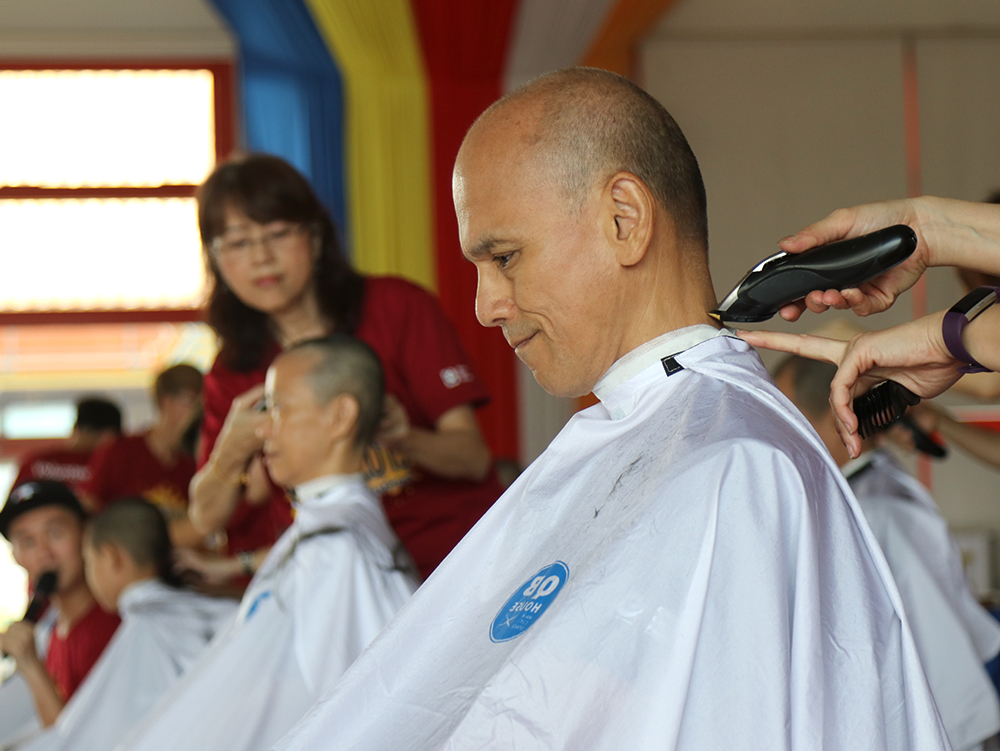 KMSPKS devotees had their heads shaved by QB House hairdressers. Image by Joshua Lee.
KMSPKS devotees had their heads shaved by QB House hairdressers. Image by Joshua Lee.
One of the beneficiaries of the Children Cancer Foundation is 14-year-old Joanna Chong.
Chong is also one of the ambassadors for Hair For Hope 2019.
Diagnosed with Medulloblastoma, a type of brain cancer, when she was 10, Chong had to to undergo surgery to remove the tumour and endure radiotherapy and chemotherapy.
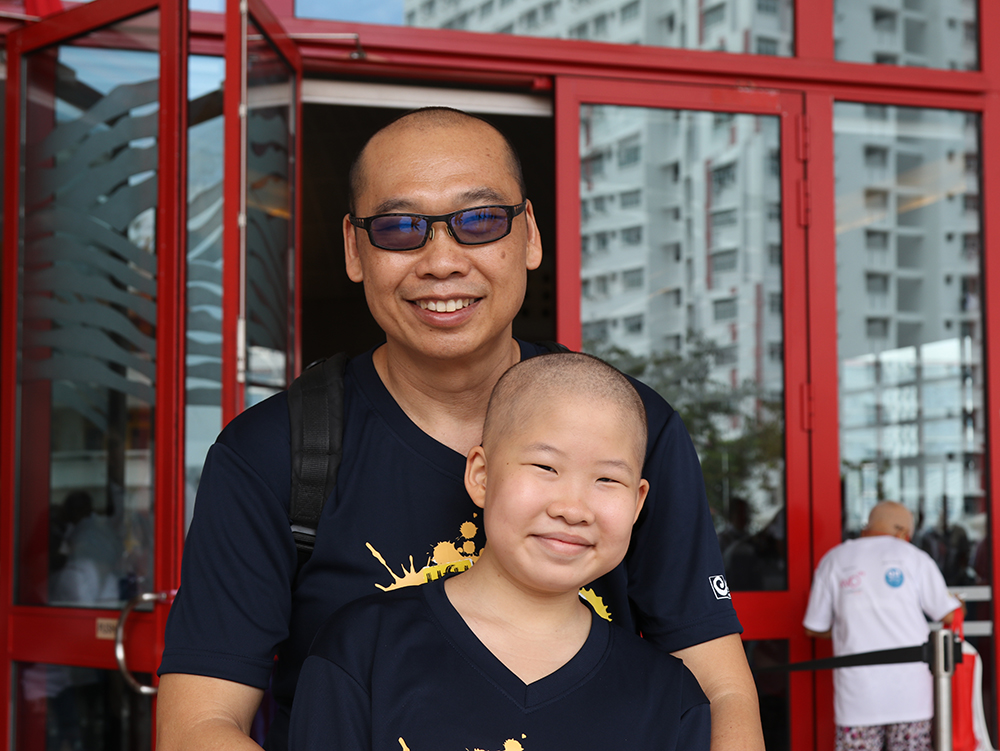 Joanna Chong and her father, Chong Hui Kwee. Image by Joshua Lee.
Joanna Chong and her father, Chong Hui Kwee. Image by Joshua Lee.
That day, Chong, who is currently in remission, was all smiles when I spoke to her.
"I feel it's quite meaningful to see so many people supporting children with cancer," she smiled shyly.
While this was Chong's first time shaving her head for Hair For Hope, her father has been doing this since 2013.
"Doing it before she was diagnosed and after she became a beneficiary, I really appreciate the work that CCF does, which is why I continue to support it," said Mr Chong, who is also a patron of KMSPSK Monastery.
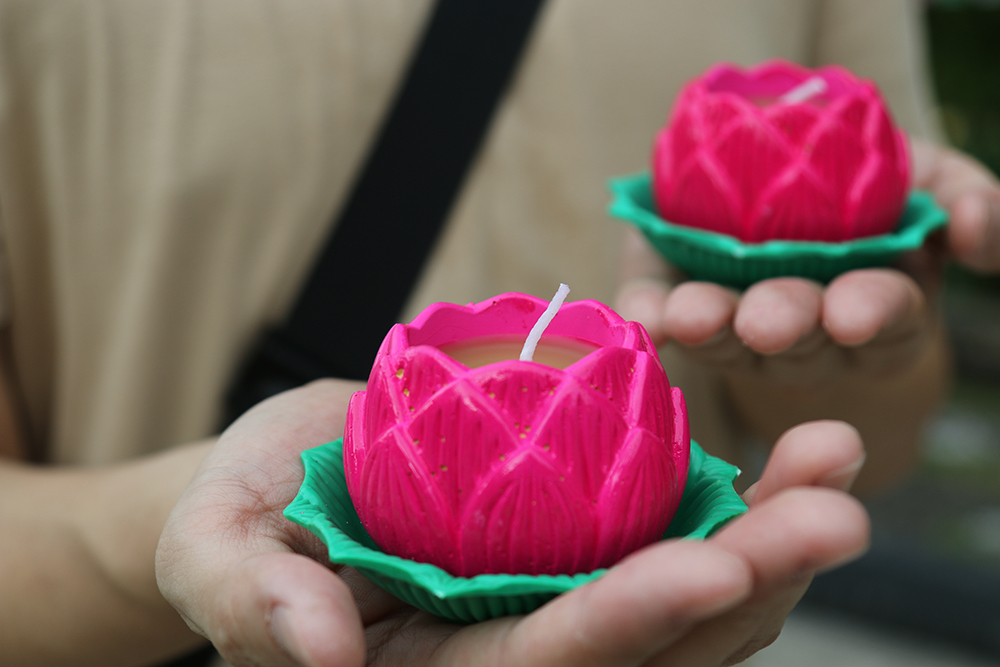 A devotee holds his candles for the Light Transference ceremony. Image by Joshua Lee.
A devotee holds his candles for the Light Transference ceremony. Image by Joshua Lee.
More than a week later on May 11, I visited the monastery again to observe the Light Transference ceremony.
During the ceremony, devotees carry lighted candles and walk in a procession around the monastery while chanting the name of the Buddha.
A lighted candle, according to Buddhism, represents light and wisdom which dispels darkness, unwholesome deeds, and ignorance.
 Devotees receiving candles for the Light Transference ceremony. Image by Joshua Lee.
Devotees receiving candles for the Light Transference ceremony. Image by Joshua Lee.
Another integral part of the Light Transference ceremony is making aspirations.
Aspirations can be made for a variety of things.
This lady wished for good health, national security, and a harmonious family.
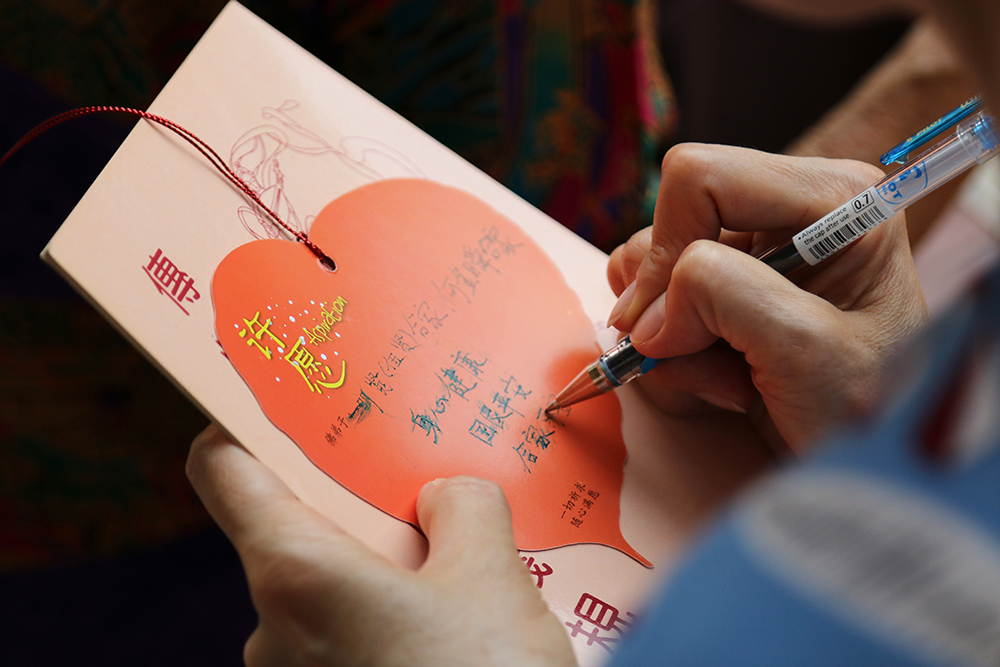 A lady pens her aspirations. Image by Joshua Lee.
A lady pens her aspirations. Image by Joshua Lee.
Even before the ceremony started proper, a large number of devotees had arrived early to reserve their seats for the procession.
Some took the time to read chants and prepare for the ceremony.
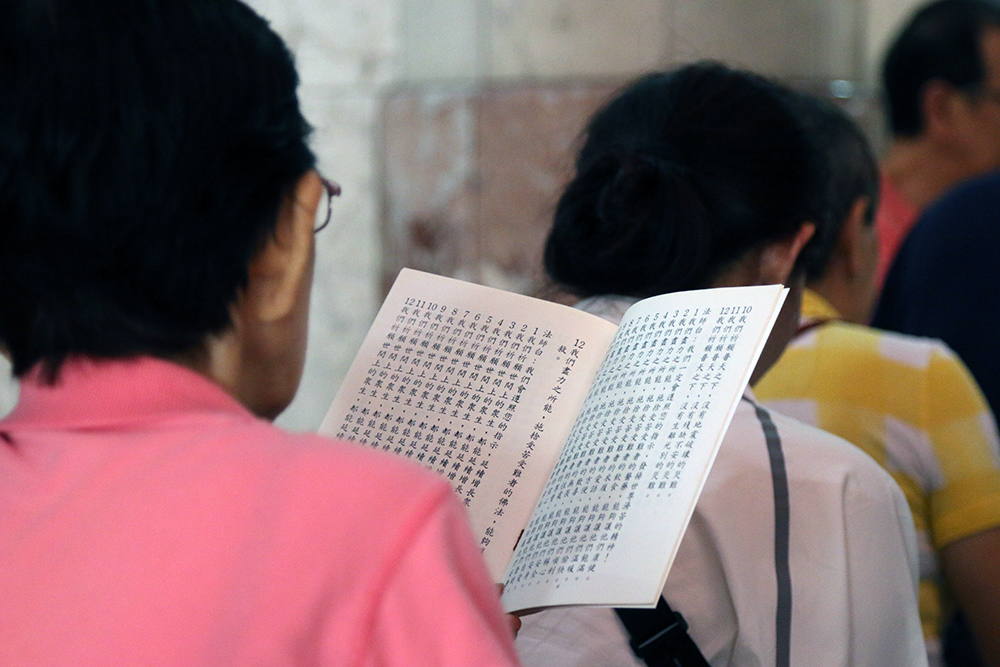 A lady prepares herself for a mass chant. Image by Joshua Lee.
A lady prepares herself for a mass chant. Image by Joshua Lee.
While the procession was led by monks, a group of lay people were tasked with carrying symbolic items like these banners which are inscribed with the different names of Buddha.
These devotees wore black ceremonial garb called Hǎi Qīng (海青).
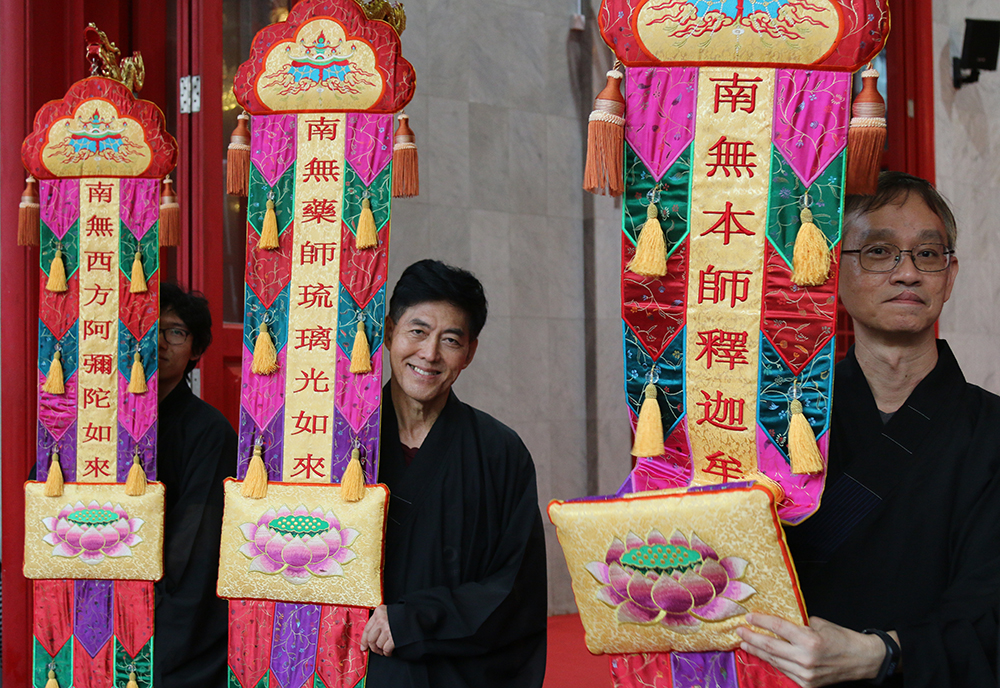 Lay people dressed in ceremonial robes carry these banners during the procession. Image by Joshua Lee.
Lay people dressed in ceremonial robes carry these banners during the procession. Image by Joshua Lee.
 Lay devotees in ceremonial garb take a group photo just before their duties commenced. Image by Joshua Lee.
Lay devotees in ceremonial garb take a group photo just before their duties commenced. Image by Joshua Lee.
Before the procession started proper, monks led the devotees in a time of chanting and meditation in the Hall of Great Compassion.
Here, the monastery's abbot Venerable Sik Kwang Sheng kneels before a statue of Guanyin.
 Venerable Sik Kwang Sheng kneeling before Guanyin. Image by Joshua Lee.
Venerable Sik Kwang Sheng kneeling before Guanyin. Image by Joshua Lee.
The monastery also broadcasted the entire Light Transference ceremony via a Facebook Live video, allowing devotees at home a front-row seat to the entire ritual.
 Religion meets tech: The Light Transference ceremony was broadcasted live. Image by Joshua Lee.
Religion meets tech: The Light Transference ceremony was broadcasted live. Image by Joshua Lee.
After a round of mass chanting, the candles were lit and the procession around the monastery started.
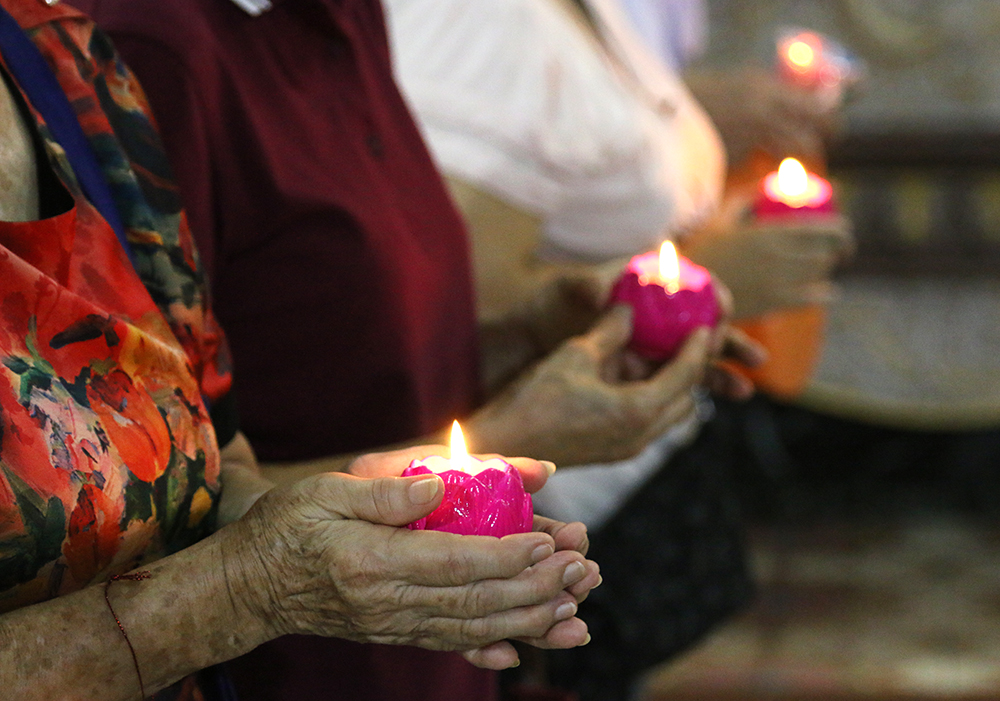 Devotees held their lighted candles as they prepared for the procession. Image by Joshua Lee.
Devotees held their lighted candles as they prepared for the procession. Image by Joshua Lee.
 The procession around the monastery. Image by Joshua Lee.
The procession around the monastery. Image by Joshua Lee.
According to the monastery, about 7,000 devotees took part in the Light Transference ceremony.
Carrying candles on a humid night was bound to be uncomfortable but the devotees soldiered on, and even chanted together as they walked.
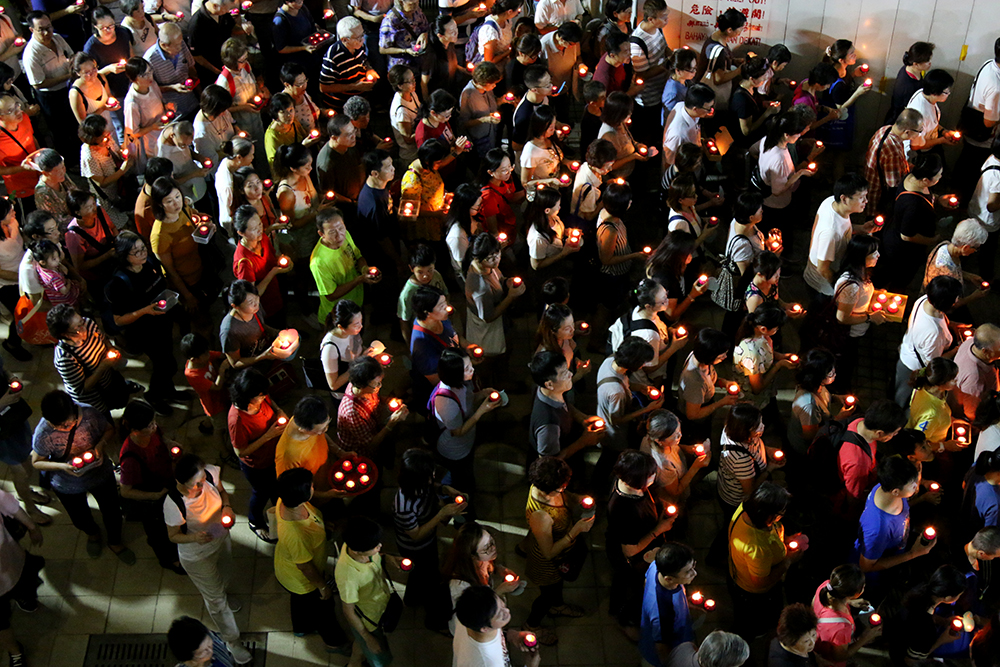 About 7,000 devotees attended the Light Transference ceremony. Image by Joshua Lee.
About 7,000 devotees attended the Light Transference ceremony. Image by Joshua Lee.
Meanwhile, volunteers at the monastery's canteen prepared noodles which were given out to famished devotees.
 The canteen staff worked quickly. Image by Joshua Lee.
The canteen staff worked quickly. Image by Joshua Lee.
 These bowls of noodles were given out free to devotees. Image by Joshua Lee.
These bowls of noodles were given out free to devotees. Image by Joshua Lee.
Finally, another week later on May 18, I arrived back at the monastery for the last major Vesak Day rituals, the Three-Step-One-Bow, and the bathing of Prince Siddhartha.
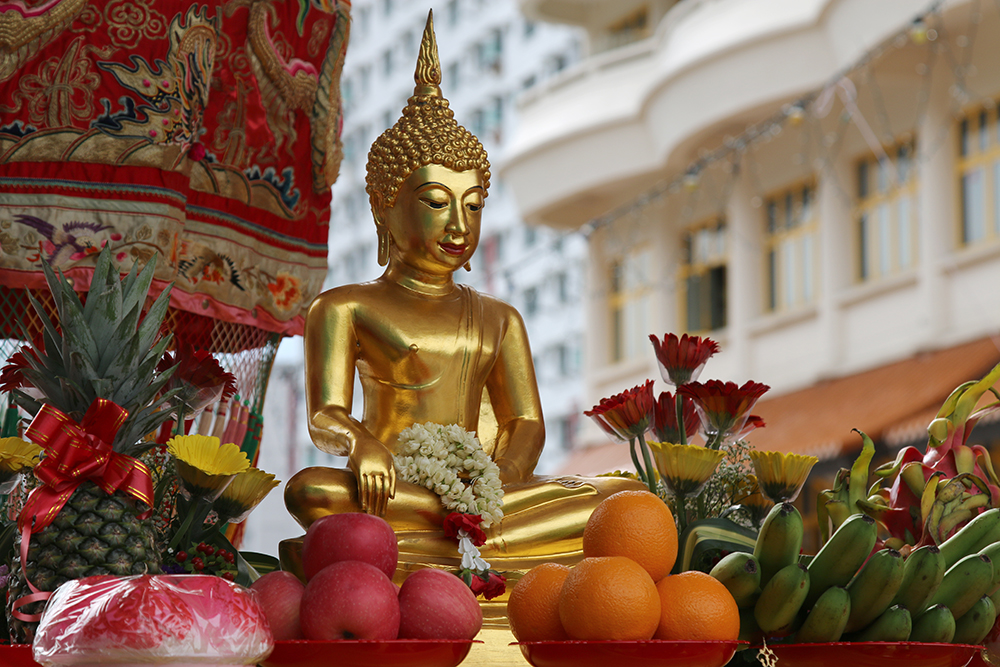 Offerings made to Buddha. Image by Joshua Lee.
Offerings made to Buddha. Image by Joshua Lee.
It was the actual Vesak Day weekend and the crowd was bigger than ever. Even hours before the actual ceremonies, the monastery was abuzz with devotees offering prayers, incense and flowers.
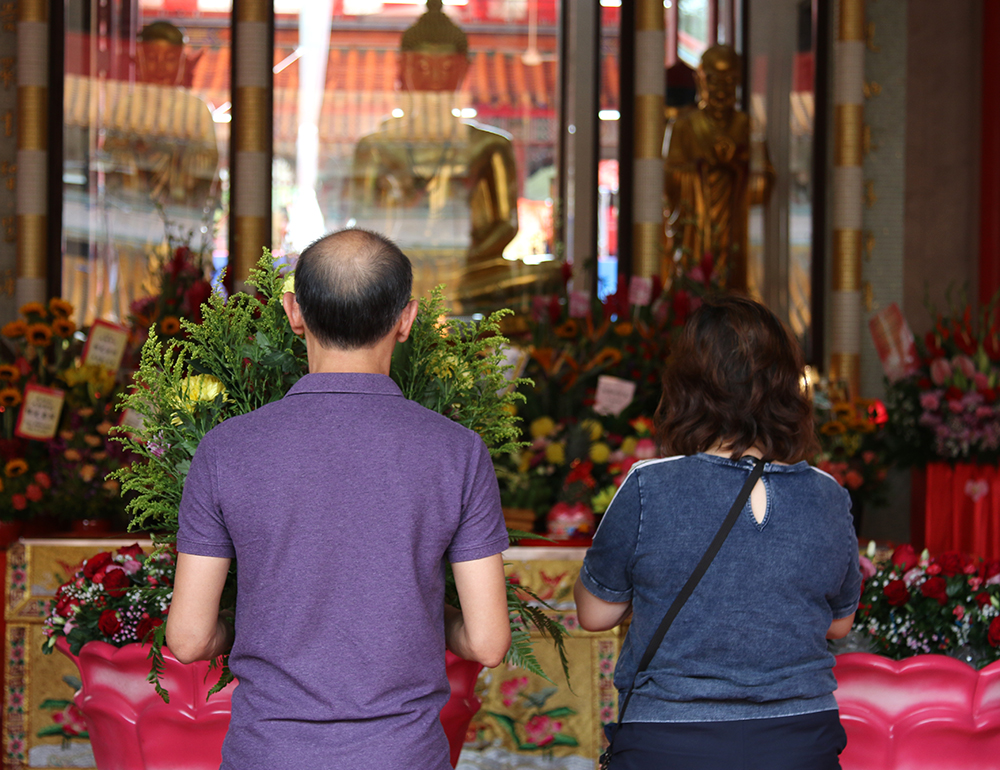 Devotees offer a bouquet of flowers and plants to the Buddha. Image by Joshua Lee.
Devotees offer a bouquet of flowers and plants to the Buddha. Image by Joshua Lee.
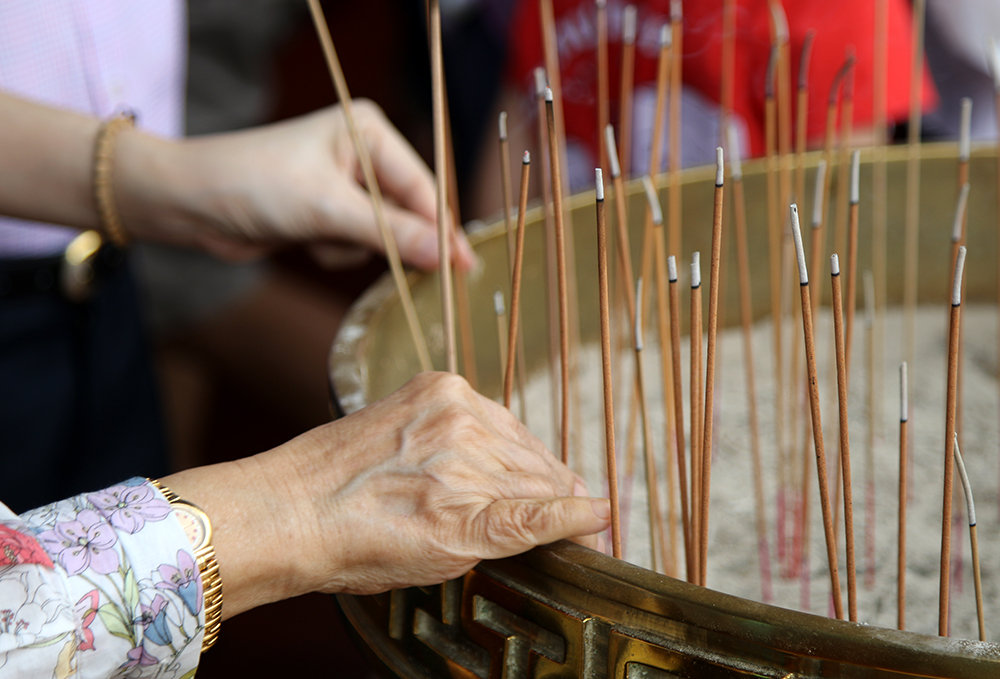 The incense pit had to be continuously cleared to make space for new incense. Image by Joshua Lee.
The incense pit had to be continuously cleared to make space for new incense. Image by Joshua Lee.
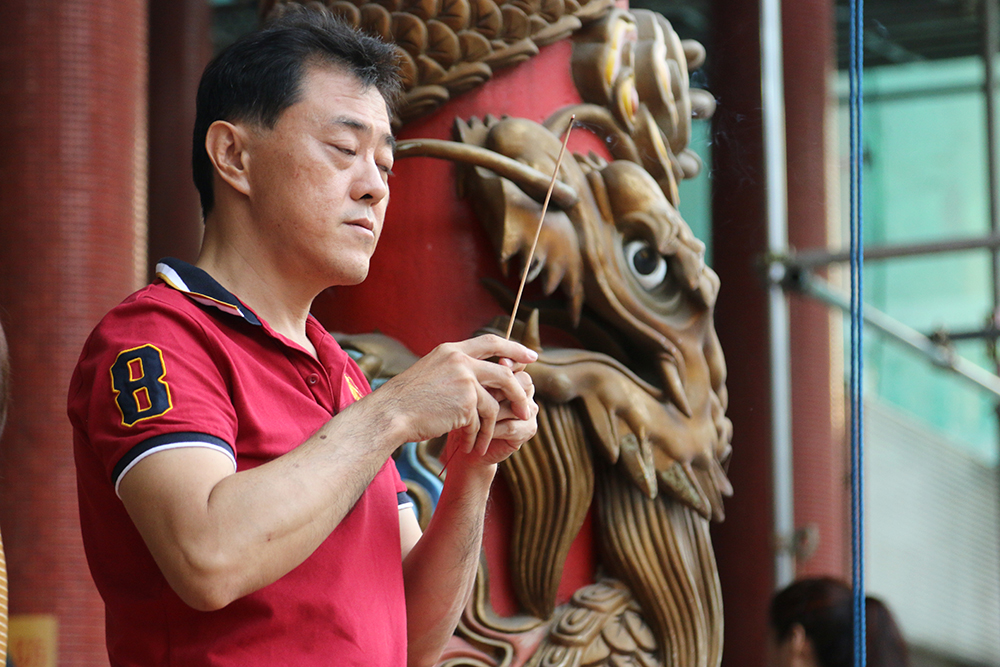 A devotee prays outside the Hall of Great Strength. Image by Joshua Lee.
A devotee prays outside the Hall of Great Strength. Image by Joshua Lee.
As the Three-Step-One-Bow ceremony drew near, devotees started gathering at the starting line.
The atmosphere was akin to a carnival fun-run, of sorts.
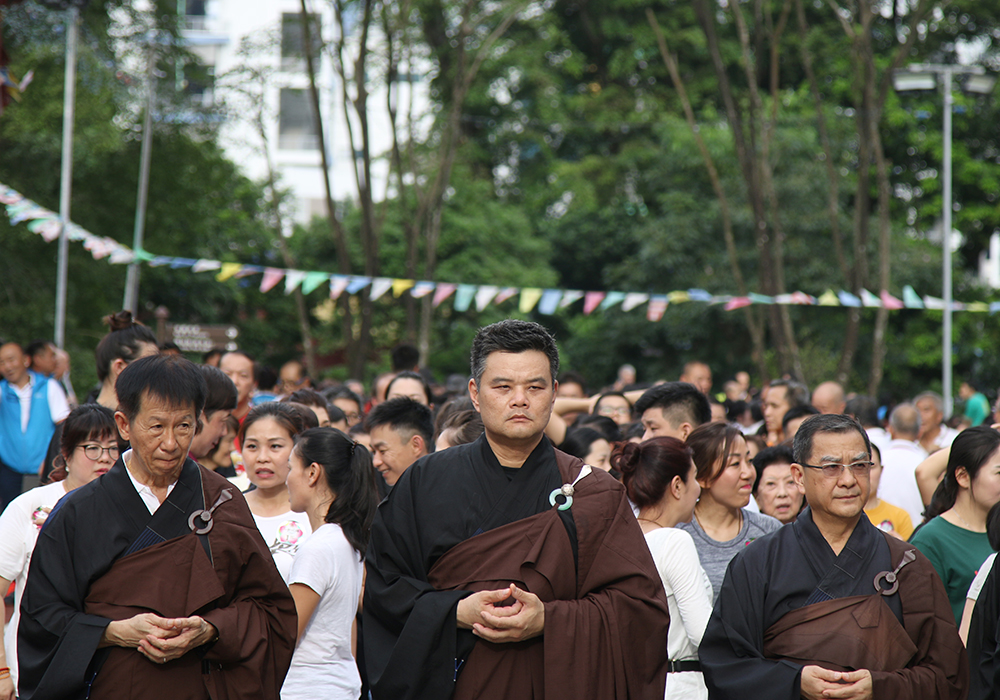 Lay devotees in their ceremonial robes preparing for the Three-Step-One-Bow procession. Image by Joshua Lee.
Lay devotees in their ceremonial robes preparing for the Three-Step-One-Bow procession. Image by Joshua Lee.
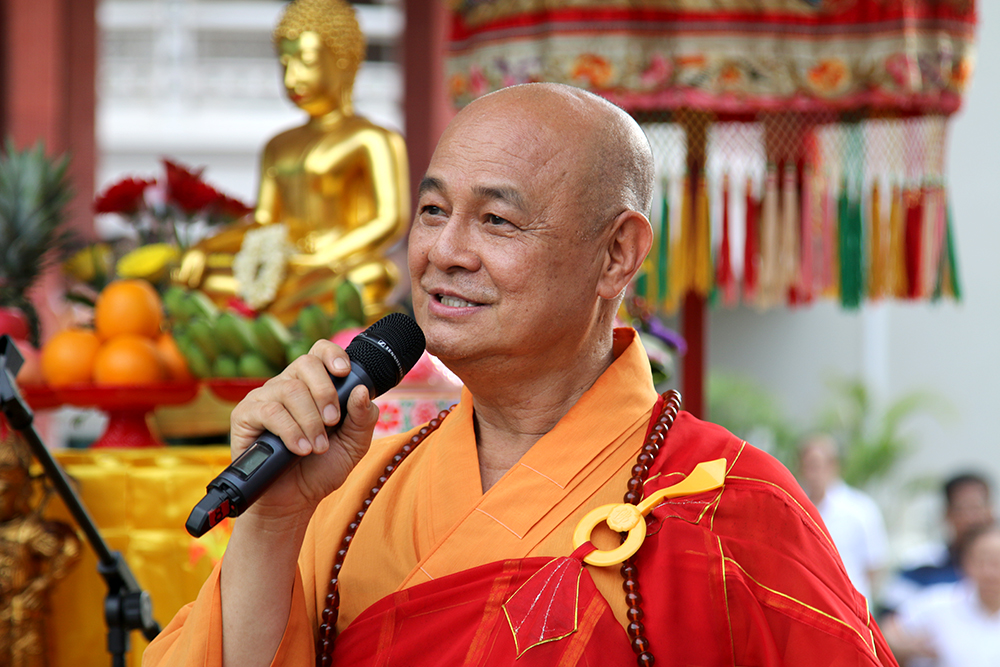 Venerable Sik welcomed everyone and thanked them for coming down. Image by Joshua Lee.
Venerable Sik welcomed everyone and thanked them for coming down. Image by Joshua Lee.
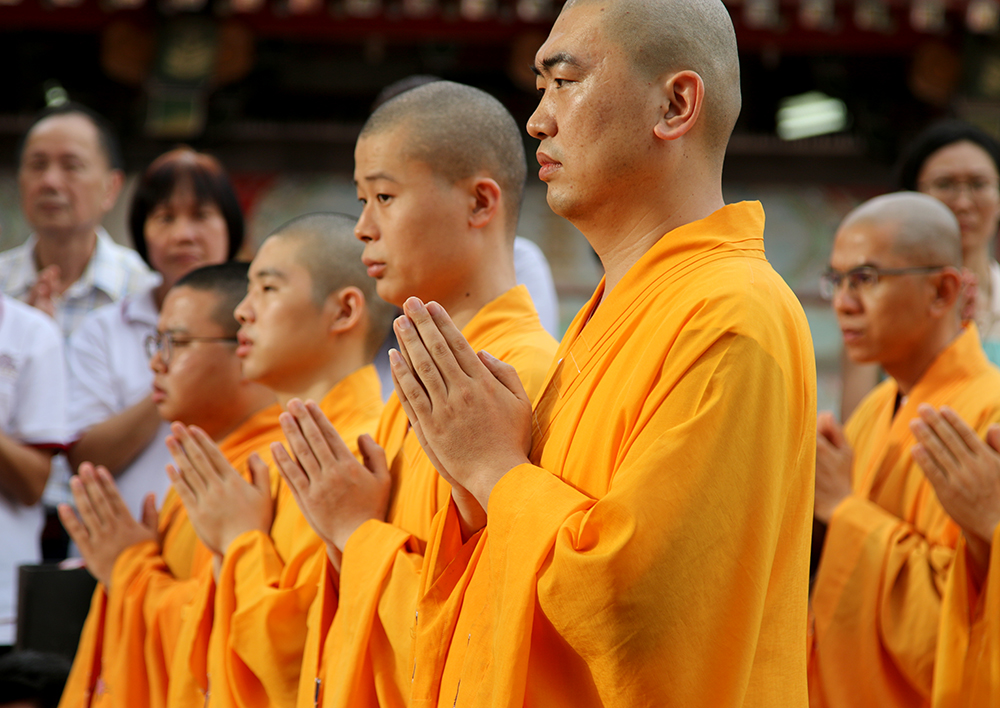 Monks in prayer. Image by Joshua Lee.
Monks in prayer. Image by Joshua Lee.
After a chanting session, the monks led the procession proper.
 The Three-Step-One-Bow procession was led by monks. Image by Joshua Lee.
The Three-Step-One-Bow procession was led by monks. Image by Joshua Lee.
Devotees took three steps before prostrating themselves on the ground with their palms facing up, while chanting a homage to Buddha. This was repeated around the perimeter of the monastery.
Each act of prostration is a sign of respect to the Buddha and is believed to help purify the mind as devotees repent of unwholesome deeds and speech.
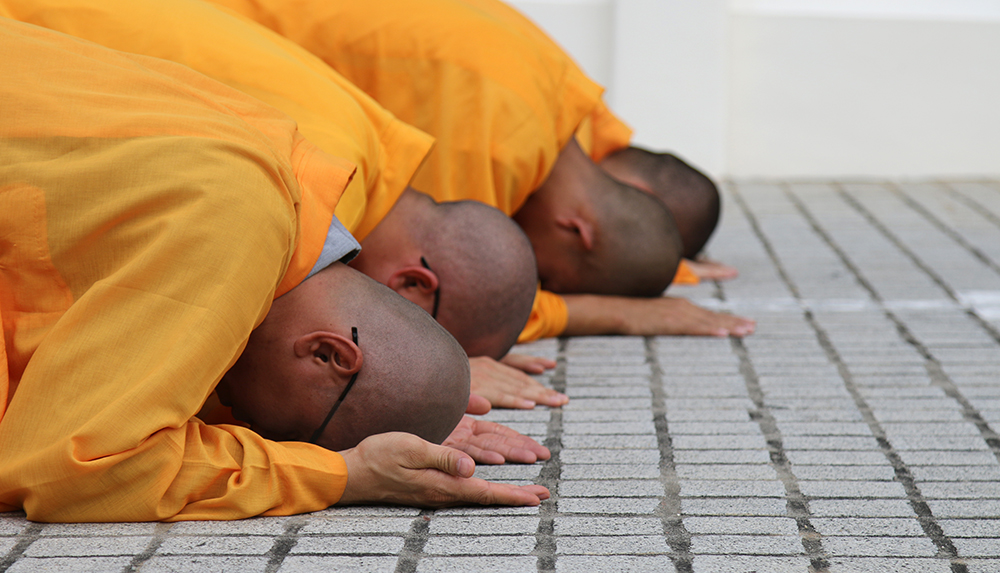 Open palms represent a lotus which signifies purity. Image by Joshua Lee.
Open palms represent a lotus which signifies purity. Image by Joshua Lee.
 Lay devotees participating in the Three-Step-One-Bow. Image by Joshua Lee.
Lay devotees participating in the Three-Step-One-Bow. Image by Joshua Lee.
The arduous and lengthy ritual reminds devotees of the difficulty journey towards enlightenment. Hence, doing it during Vesak Day is considered by many to be very meritorious.
 According to the monastery, about 30,000 devotees took part in the ceremony. Image by Joshua Lee.
According to the monastery, about 30,000 devotees took part in the ceremony. Image by Joshua Lee.
 A child glances at his mother as they participated in the Three-Step-One-Bow ritual. Image by Joshua Lee.
A child glances at his mother as they participated in the Three-Step-One-Bow ritual. Image by Joshua Lee.
The procession culminated in front of the Hall of Great Compassion where Venerable Sik sprinkled holy water on devotees who completed the journey.
As you can imagine, the cool water was a welcome respite for them. Many whooped and yelled "Thank you!" as they were drenched.
 Venerable Sik sprinkling holy water on devotees at the end of their journey. Image by Joshua Lee.
Venerable Sik sprinkling holy water on devotees at the end of their journey. Image by Joshua Lee.
Meanwhile other devotees were at the Hall of Great Compassion pouring perfumed water on a small statue of a baby Prince Siddhartha (who later became the Buddha), to signify his birth.
 The statue of a baby Prince Siddhartha was adorned with flowers. Image by Joshua Lee.
The statue of a baby Prince Siddhartha was adorned with flowers. Image by Joshua Lee.
This ritual comes from the story of the prince who was believed to have pointed one hand to the sky and another the the earth when he was born.
Immediately after he was born, streams of water came pouring down from heaven.
Today, devotees replicate that scene by bathing his statue while aspiring to purify their own minds.
 Perfumed water is poured over a statue of an infant Prince Siddhartha. Image by Joshua Lee.
Perfumed water is poured over a statue of an infant Prince Siddhartha. Image by Joshua Lee.
The Kong Meng San Phor Kark See Monastery is located at 88 Bright Hill Rd, Singapore 574117 (map).
Special thanks to the KMSPKS Monastery and my Buddhist guide, Loh Wei.
If you like what you read, follow us on Facebook, Instagram, Twitter and Telegram to get the latest updates.
